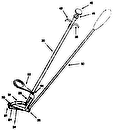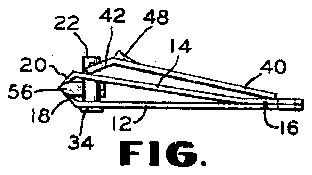
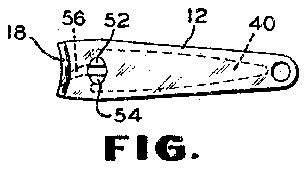
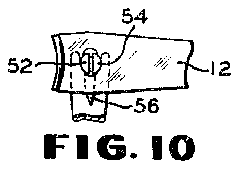
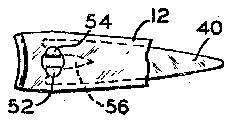
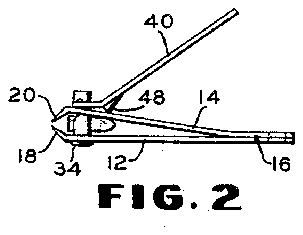
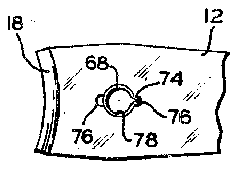
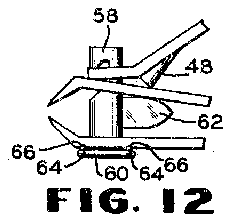
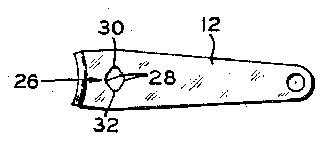
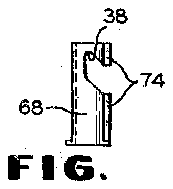
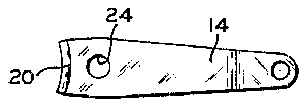
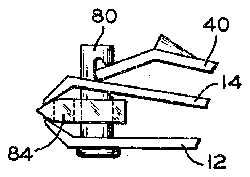
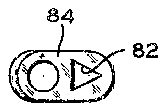
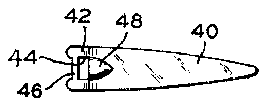
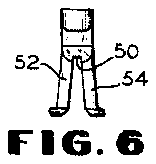
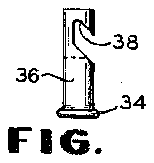
- 8pin
- 12blade members
- 13mating cutting edges
- 14blade members
- 16tack weld
- 18cutting edges
- 20cutting edges
- 22pin
- 25june
- 26opening
- 28intermediate arcuate surfaces
- 29cutting edges
- 30end arcuate surfaces
- 32end arcuate surfaces
- 34head portion
- 36body portion
- 38hook-like opening
- 40lever
- 42portion
- 44aperture
- 48stamped arcuate pressure means
- 50longitudinally extending slot
- 52bifurcations
- 53pin
- 54bifurcations
- 56wiping member
- 58pin
- 60circular head portion
- 62wiping member
- 64projections
- 66indents
- 68pin
- 70longitudinally extending opening
- 72wiping member
- 74flanges
- 76indents
- 78circular opening
- 80pin
- 82triangular opening
- 84wiping member
- 360fixed thereto for rotation also rotates
- 389bowers
- 436 bhio
- 462bowers
- 766references cited united states patents
- 960references cited united states patents
Description
June 25, 1968 T. s. BowERs 3,389,462
WIPING, HONING, AND/OR INDEXING DEVICE FOR CLIPPERS Filed April 26, 1967 FIG. I3
2o ,4 FIG. I4 FICG. 5
FIG. 4
FIG.5
INVENTOR. THOMAS S. BOWERS v ATTORNEY United States Patent 0 3,389,462 WlPiNG, HQNlNG, AND/UR lNDEXlNG DEVlCE FQR CLWPIERE Thomas S. Bowers, 35544 Grantley Road, Toledo, (Bhio 436% Filed Apr. 26, 1967, Ser. No. 633,928 17 Claims. (Cl. fad-2n) AhE'lFRACT 0F THE BESCLQSURE This disclosure pertains to a conventional fingernail clipper wherein a flexible wiping member is secured for rotation with the pin of the clipper when the pressure lever of the clipper is rotated from its closed carrying position to an open position ready for operation by the user. The wiping member may also be of such a material and construction that the cutting edges of the clipper blade members are honed by the wiping member to sharpen the cutting edges. Furthermore, the disclosure sets forth a resilient pin, either in the form having a longitudinal slot with resilient bifurcations or a hollow cylindrical member with longitudinally extending indexing flanges, which cooperate with appropriate openings in the blade member to releasably index the lever means in its closed carrying position or open operating position so that the lever does not pivot upon operation thereof. Such indexing means may alternatively be provided by appropriate projections and indents on the internal portion of the head of the pin and the undersurface of the bottom blade member.
Background of the invention Field of the inventi0n.The field of the invention is basically cutting devices and more particularly such devices which utilize a pair of resilient blade members forced into cutting position by operation of a lever.
Description of prior art-The prior art involves the standard fingernail clipper which utilizes a pair of coopcrating cutting blades forced into operation by a lever anchored on a pin extending through the cutting blades. When the lever is in open operating position and the clippers are in the hand of the user, pressure applied by the thumb of the user is at an angle often resulting in pivoting of the lever away from its completely open operating position. Thus, the force available for effecting a cutting operation is diminished.
While prior art clippers have utilized a clip or groove in the upper surface of the blade member to accommodate the end of the lever when the lever is pivoted to closed position; and, while other prior art clippers have utilized means on the lever and blade to prevent rotation of the lever when it is in the open operating position insofar as is known, no such means has been provided to prevent rotation of the lever both when it is in open operating position and when it is in closed position, nor has such means been associated with the pin.
Furthermore, after the cutting operation is effected the nail which has been sheared falls between the blade members and due to the construction of the blade members and cutting means thereon, the nail or other debris which has been sheared remains between the blade members and can prevent the blade members from being forced together to perform the next cutting operation.
Summary of the invention This invention relates to a cutting device having a pair of blade members secured together at one end with the other ends of the blade members being spaced apart and having cutting means which cooperate to perform a cutting operation when moved toward each other. A pin means extends through the blade members adjacent the cutting means thereof and has a pressure lever secured thereto for rotation while being movable in a pivotal relationship with respect to the pin to apply operating pressure to one of the cutting blades. A flexible wiping, cleaning, and/ or honing device is associated with the pin means and is rotatable therewith upon rotation of the lever to either wipe debris from between the blades or to provide honing of the cutting means of the blades. This automatic Wiping of the debris (such as a sheared fingernail) upon rotation of the operating lever eliminates the user being required to strike the clipper sharply against the users hand or other object in an attempt to jar loose or free the retained debris.
Another concept of this invention involves indexing means associated with at least one of the blade members and the pin means to releasably position the operating lever in the desired open or closed position. The indexing of the lever member in either the open or closed position, like operation of the wiping member, occurs automatically upon rotation of the lever and these changes have been made with a minimum of additional cost to the manu facturer of the clipper.
In summary, it is an object of this invention to provide a low cost automatically operable wiping member to clean debris from the cutting blades and also to provide low cost means for indexing the operating lever in its open and/or closed position.
These and other objects and advantages of this in vention will become apparent from the following detailed description when taken in connection with the accompanying drawings.
Brief description of the drawings FIG. 1 is a side elevation view of a clipper embodying this invention with the lever member pivoted to the closed carrying position;
FIG. 2 is a side elevation view of a clipper embodying this invention with the lever member pivoted to the open operating position;
FIG. 3 is a plan view of the lower blade member of the clipper shown in FIGS. 1 and 2;
FIG. 4 is a plan view of the upper blade member of the clipper shown in FIGS. 1 and 2;
FIG. 5 is a plan view of the lever member of the clipper shown in FIGS. 1 and 2;
FIG. 6 is an enlarged front elevation view of the pin shown in the clippers of FIG. 1 and 2;
FIG. 7 is a side elevation view of the pin of the clipper shown in FIGS. 1 and 2;
FIG. 8 is a longitudinal section viewof the pin shown in FIGS. '6 and 7 with the wiping member shown in its assembled position;
FIG. 9 is a bottom view of the clipper shown in FIGS. 1 and 2 when the lever, and thus the pin and wiper, is pivoted to its closed carrying position;
FIG. 10 is a bottom view of the clipper when the lever, and thus the pin and wiper, is pivoted to an intermediate position (between the open and closed position);
FIG. 11 is a bottom view of the clipper when the lever, and thus the pin and wiper, is pivoted to the open operating position;
FIG. 12 is a partial enlarged side elevation view of another embodiment of this invention;
FIG. 13 is a partial enlarged bottom view of another embodiment of this invention;
FIG. 14 is a cross sectional view of the pin and wiping member shown in the embodiment of FIG. 13;
FIG. 15 is a side elevation view of the pin of the embodiment shown in FIGS. 13 and 14;
FIG. 16 is an enlarged partial side elevation view of another embodiment of this invention; and
FIG. 17 is a plan view of the wiping member shown in the embodiment of this invention illustrated in FIG. 16.
Description of the preferred embodiments Referring now more particularly to the drawings, a fingernail clipper designated generally at 1th is shown assembled in FIGS. 1 and 2 and comprises a first or bottom elongated blade member 12, illustrated in FIG. 3, and a second or top elongated blade member 14, similar in construction to blade member 12 and illustrated in FIG. 4. The top blade member 14 ditl'ers slightly from the bottom blade member 12 in that the blade is bent adjacent one end so that when the top and bottom members are aligned with their one end placed in engagement and firmly secured in such a position by any suitable means such as a tack weld 16, the opposite ends of the blade members 12 and 14 are positioned in spaced relationship.
Cutting means is provided on the spaced ends or" the blade members 12 and 14. Such cutting means takes the form of mating cutting edges 13 and provided by angularly bending the ends of blade members 12 and 14 respectively and honing such to a sharp edge.
Adjacent the cutting edges 18 and 2% of the blade members, the blade members are provided with openings for the reception of a pin 22. which is shown most clearly in FIGS. 6 and 7. The opening 24 in the top member is, in this embodiment, of circular configuration. Whereas, the opening 26 in the bottom member is generally elliptical in shape. Thus, the opening 26 has intermediate arcuate surfaces 28 constructed from one radius and end arcuate surfaces 30 and 32 displaced further from the center of the elliptical opening than the intermediate arcuate surfaces 28.
The pin 22 comprises a head portion 34 and a body portion 36 and is adapted to extend through the openings 24 and 26 and protrude above the top blade 14. The body portion 36 of the pin which extends above the top blade 14 is provided with receiving means in the form of a booklike opening 38 which is adapted to cooperate with a lever 40 which is illustrated in FIG. 5.
More particularly, the lever 40 is an elongated member slightly shorter in length than the blade members 12 and 14 and is provided with a bent over portion 42 adjacent one end thereof. The bent over portion is apertured at 44 so as to provide a cross bar 46 which is sized to be received in the hook-like opening 38 of the pin 2.2.
The lever 40 is provided with a stamped arcuate pressure means 48 adjacent the aperture 44 so that when the lever is attached to the pin 22 the arcuate pressure means rests on the upper surface of the top blade 14 adjacent the cutting end of the blade. With this construction, it is apparent that the lever is held in the hook-like opening 38 of the pin member by the resiliency of the blade members 12 and 14 and when the lever is rotated in a 360 arc the pin which is fixed thereto for rotation also rotates 360. Furthermore, the operable connection between the lever and the pin is such that the lever may be pivoted or inverted from its closed position shown in FIG. 1 and then rotated to its open position shown in FIG. 2 while still being retained by the hook-like opening 38 due to the resiliency of the blade members.
As most clearly shown in FIG. 6, the pin 22 has a longitudinally extending slot 50 which forms bifurcations 52 and S4 of the lower end of the pin. The pin is constructed of a material such that when the bifurcations are forced towards each other, due to the inherent resiliency, they tend to return to their original position.
The head portion 34 of the pin and the undersurface of blade member 12 cooperates with each other to provide means for preventing axial movement of the pin towards the second blade member and thus anchor the pin while still permitting rotation thereof.
Means is provided in association with the pin for automatic rotation therewith upon rotation of the lever 40 to clear debris from the area between the blade members.
More particularly, in this embodiment as shown in FIG. 8, a wiping member 56 of generally L-shaped construction is placed in the slot 5b with the wiping portion protruding transversely therefrom. In this construction, as most clearly shown in FIGS. 1 and 2 the wiping member 56 is held against axial or pivotal movement from the slot either by engagement with the top blade member or the bottom blade member and furthermore is securely held by the pin for rotation therewith.
The protruding portion of the wiping member 56 is greater in length than the displacement of the pin 22 from the cutting edges 18 and 2d of the blade members so that the wiping member will extend into the corners of the cutting edges 18 and 20 and remove debris therefrom. For this purpose, it is apparent that the wiping member 56 need be a flexible member and to this end the wiping member may be of any resilient material such as rubber or plastic which will withstand the wear involved. It is apparent from viewing FTGS. 8 and 9 that the height of the wiping member 56 is greater than its width. Furthermore, the wiping member 56 may be of a suitable material which, when run across the cutting edges 18 and 29 will serve as a honing device and sharpen the edges for further use.
Referring now to FIGS. 9, l0, and 11, the operation of the indexing means will become apparent. In FIG. 9 the heads of bifurcations 52 and 54 are positioned in engagement with the end arcuate surfaces 3%) and 32, respectively, and the lever means is in its closed carrying position as shown in FIG. 1. In such a position the bifurcations 52 and 54 are fully circumferentially expanded and the resiliency of the bifurcations tend to index the lever in such closed position. When it is desired to move the lever 40 to the operating position shown in FIG. 2, the lever 40' is first pivotally inverted and then rotated to the intermediate position shown in FIG. 10 wherein the bifurcations 52 and 54 have been compressed against the resiliency thereof. The lever 40 is further rotated another 90 to the position shown in FIG. 2 (and in dotted lines in FIG. 11) at which time the bifurcations 52 and 54 spring out into engagement with the end arcuate surfaces 32 and 30, respectively (positions being reversed from the closed position), to index the lever in its open position as shown in FIG. 2. Thus, when the user applies pressure to the lever member 46 to perform a cutting operation, he can do so and the lever will not rotate from its open position due to the resisting resiliency of the indexed bifurcations of the pin.
Refer now more particularly to the embodiment of the invention shown in FIG. 12, where members similar to those described in the previous embodiment will be given like reference characters. The construction of the clipper in this embodiment is similar to the one previously described in that a pair of cutting blades 12 and 14 with cutting surfaces 18 and 2b are adapted to be operated by a lever 40. The pin 58 differs from that shown in the previous embodiment in that the pin is not provided with a longitudinal slot but is of solid body construction with a circular head portion 60. The wiping member 62 can be secured to the pin 53 for rotation therewith in any number of suitable manners, such as by adhesive bonding. In this embodiment the undersurface of the circular head portion 60 of the pin is provided with a pair of projections G4 which cooperate with conforming indents 66 provided on the undersurface of the bottom blade member 12 so that the pin is resiliently indexed in either the open or closed position. It is apparent that the projections 64 and the indents 66 may be reversed so that the projections are provided on the blade member and the indents provided in the pin head. Thus, when it is desired to rotate the lever 40, suitable rotational pressure will overcome the resilient indexing to permit the same while suflicient resistance is provided to rotation during the cutting operation.
Referring now to FIGS. l3l5, another embodiment of this invention is shown wherein alternative indexing means and wiper securing means is provided. More particularly, a pin 68 of generally hollow cylindrical configuration is provided. The cylinder is provided with a longitudinally extending opening 70 through which the wiping portion of a wiping member 72 extends. The body portion of the wiping member "72 is of a cylindrical configuration conforming to that of the pin member in Which it is encased. For purposes of indexing the lever in the open and closed position, longitudinally extending flanges 74 are provided adjacent the longitudinally extending opening 70 and such flanges cooperate with indents 76 displaced 180 on a circular opening 78 provided in the bottom blade member 12. If so desired, the top blade 14 may similarly be provided with a circular opening 78 and opposed indents 76. Thus, in operation, the flanges 74 are indexed in the indents 76 when the lever is positioned in the open or closed position and by suitable rotational pressure the circumferential resiliency of the pin 68 is overcome to remove the flanges 74 from the indents 76 to permit rotation of the lever. The wiping member 72 is firmly secured in the pin 68 since it is encompassed thereby and is prohibited from axial movement with respect thereto by engagement of the wiping portion with the top or bottom blade.
Referring now to the embodiment of this invention shown in FIGS. 16 and 17, the blade members 12 and 14 are again operated by the lever 40 but in this case the pin 8% is triangular in cross-section and cooperates with a triangular opening 82 in a wiping member 84 so that the wiping member rotates as a unit therewith. In this case the blade members 12 and 14 are provided with circular openings to accommodate the pin 80. To aid the wiping action of the wiping member 84 upon rotation of the lever 40, the wiping member is provided with an aperture, in this case circular, to permit additional flexibility of the wiping portion of the member and enable it to more easily clean the corners of the cutting edges 18 and 20.
While various embodiments of this invention have been described in detail, it is apparent that there may be many changes in structure and operation without departing from the scope of this invention as defined by the following claims.
What is claimed is:
1. In a cutting device having (a) a first blade member,
(b) a second blade member cooperable with said first blade member so that when one end of said first blade member is placed in engagement with one end of said second blade member the other ends of said first and second blade members are positioned in spaced relationship,
(c) means securing said one end of said first and second blade members against movement with respect to each other,
(d) cutting means associated with said other ends of said first and second blade members to perform a cutting operation when said other ends are moved toward eacn other,
(e) pin means extending between and through said other ends of said first and second blade members and having receiving means adjacent one end thereof,
(f) means associated with the other end of said pin means and said first blade member for preventing movement of said pin means axially toward said second blade member while permitting rotation of said pin means,
(g) lever means positioned on top of said second blade member and having means adjacent one end thereof cooperable with said receiving means of said pin means whereby said lever may pivot with respect to said pin means while the two are fixed together for rotation,
(h) pressure means on said lever means positioned between the ends thereof so that when a force is applied to the other end of said lever means, said pressure means moves the cutting means on the other ends of said first and second blade members together, the improvement comprising wiping means having a height which is measured along the longitudinal axis of said pin means being greater than its width which is measured in a plane transverse to the longitudinal axis of said blade members, said Wiping means being associated with said pin means and movable rotationally therewith to wipe debris from between said blade members.
2. The combination of claim 1 wherein said wiping means has a free end tapered to conform to the shape of said cutting means and protrudes from said pin means a greater distance than the pin means is displaced from said cutting means of said blade members whereby said wiping means cleans the entire surface of said cutting means.
3. The combination of claim 2 wherein said wiping means is a flexible member which moves between said blade member cutting means upon rotation of said pin means.
4. The combination of claim 3 wherein said wiping means serves as a honing device to sharpen the cutting means of said blade members.
5. The combination of claim 1 wherein said pin means has a longitudinally extending slot and said wiping means is positioned in said slot between said blade members and protrudes from said slot so that the wiping means is positioned against movement with respect to said pin means both in the axial and transverse direction.
6. The combination of claim 1 wherein said pin means comprises a hollow cylinder and said wiping means is disposed within said hollow cylinder between said blade iembers and protrudes from said hollow cylinder so that said wiping means rotates with said pin means.
7. The combination of claim 1 wherein said pin means is an acircular member and said wiping means has a matching acircular opening through which said pin means extends whereby said pin means and wiping means rotate together as a unit.
8. The combination of claim 1 wherein said wiping means is provided with an opening in the protruding end thereof to increase its flexibility.
9. In a cutting device having (a) a first blade member,
(b) a second blade member cooperable with said first blade member so that when one end of said first blade member is placed in engagement with one end of said second blade member the other ends of said first and second blade members are positioned in spaced relationship,
(0) means securing said one end of said first and second blade members against movement with respect to each other,
(d) cutting means associated with said other ends of said first and second blade members to perform a cutting operation when said other ends are moved toward each other,
(e) pin means extending between and through said other ends of said first and second blade members and having receiving means adjacent one end thereof,
(f) means associated with the other end of said pin means and said first blade member for preventing movement of said pin means axially toward said second blade member while permitting rotation of said pin means,
g) lever means positioned on top of said second blade member and having means adjacent one end thereof cooperable with said receiving means of said pin means whereby said lever may pivot with respect to said pin means while the two are fixed together for rotation,
(h) press-are means on said lever means positioned between the ends thereof so that when a force is applied to the other end of said lever means, said pressure means moves the cutting means on the other ends of said first and second blade members together, the improvement comprising indexing means on said pin means and at least one of said blade members whereby said lever means is releasably positioned in a desired rotational position with respect to said blade members.
10. The combination of claim 9 wherein said pin means includes a head portion and said indexing means comprises cooperating projections and indents on the undersurface of said pin head and the surface of said first blade member.
11. The combination of claim 9 wherein the indexing means comprises a pair of means on said one blade member displaced rotationally 180 from each other and each cooperable with means formed on said pin means to releasably index the pin means and thus the lever means alternatively in open and closed position.
12. The combination of claim 9 wherein said indexing means includes resiliently circumferentially expandable means on said pin cooperating with means forming an acircular opening in one of said blade members.
13. The combination of claim 12 wherein said resiliently circumferentially expandable pin means comprises a pin with a slot extending longitudinally thereof to form bifurcations which are received in a generally ellipticalshaped Opening in said one blade member.
14. The combination of claim 12 wherein said resiliently circumferentially expandable pin comprises a hollow cylinder with longitudinally extending flanges which cooperate with detents in at least one of said blade members to position said pin member and thus said lever means in a desired position while being releasably movable to another rotational position.
15. The combination of claim 9 wherein means is associated with said pin means and movable rotationally therewith to wipe debris from between said blade members.
16. The combination of claim 15 wherein said wiping means has a height greater than its width and has a free end tapered to conform to the shape of said cutting means and protrudes from said pin means a greater distance than the pin is displaced from said cutting means on said blade members whereby said wiping means moves between the cutting means of said blade members upon rotation of said pin means.
17. The combination of claim 16 wherein said wiping means serves as a honing device to sharpen the cutting means of said blade member.
References Cited UNITED STATES PATENTS 2,960,766 11/1960 Whittle 30-28 2,739,379 3/1956 Bassett 30-28 WILLIAM W. DYER, ]R., Primary Examiner.
OTHELL M. SIMPSON, Examiner.



